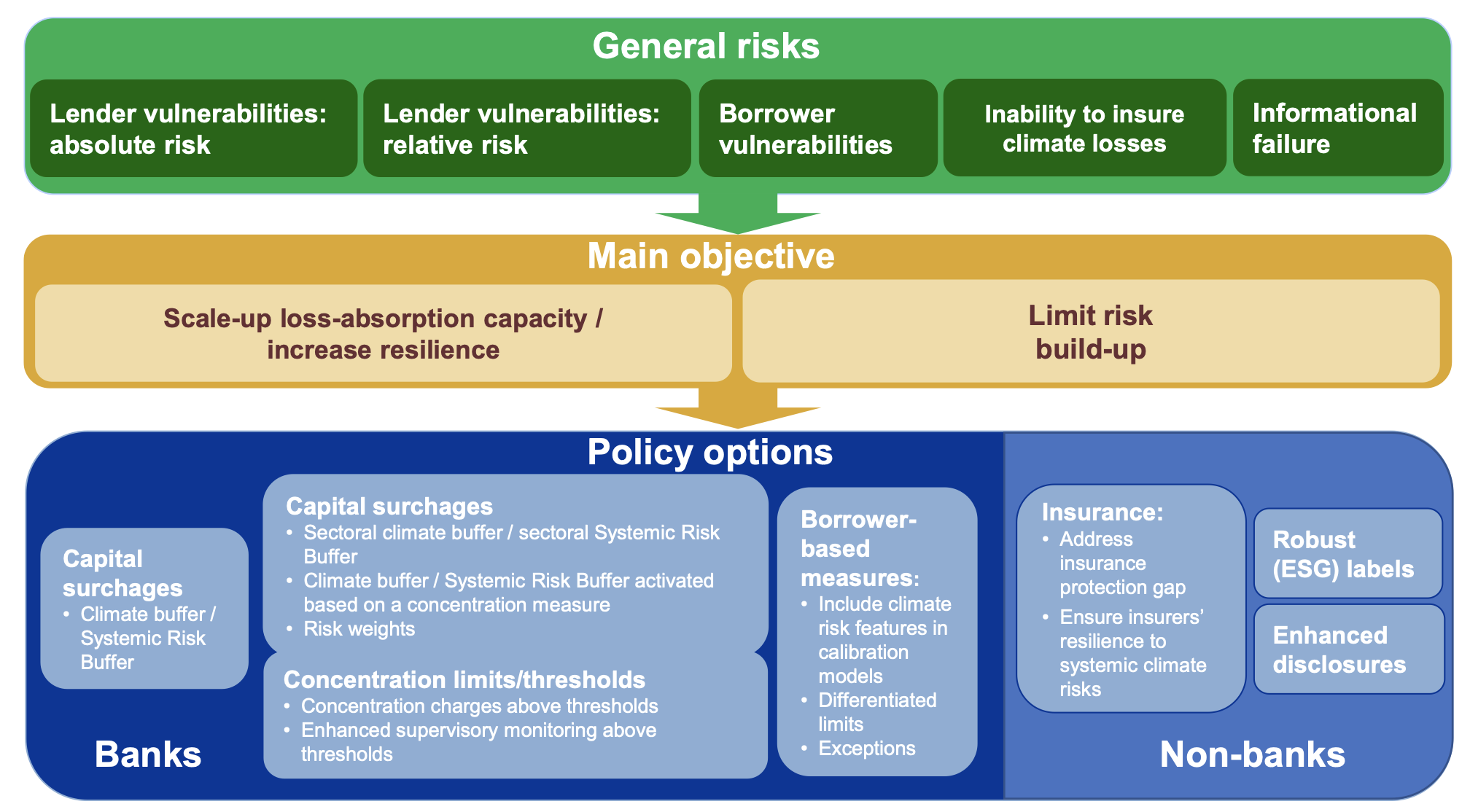A growing body of analysis has provided a firm basis to inform a financial stability view on climate (see de Bandt et al. 2023 for a review of recent evidence on climate risk for banks). A framework for macroprudential monitoring, curating this body of evidence, would consist of three building blocks: the evolution of climate shocks, the topology of exposures, and the potential for financial risk (see Figure 1).
Figure 1 Surveillance framework for climate-related financial stability risks
Source: ECB/ESRB (2023).
Note: Indicators listed in each category are not exhaustive, but rather the subset explicitly covered in the report.
Tracking the scope for climate-related shocks constitutes the initial building block of a surveillance framework. Such shocks appear to be intensifying in noteworthy ways. On the one hand, a growing voracity of floods, water stress, wildfires, and droughts illustrate the acute physical aspects of chronic hazards such as rising sea levels.
On the other hand, the transition risk from decarbonisation efforts is set to intensify, as nation states and firms seek to implement a growing set of net zero pledges. Growing scrutiny from forward-looking financial markets may suggest the scope for anticipation and some associated sudden repricing of purportedly distant climate shocks.
This strengthening intensity of climate hazards, alongside looming energy transition needs, may imply the prospect of compound climate and financial shocks. At the same time, depleting carbon budgets are bringing global warming perilously close to ‘tipping points’ whereby non-linearities may kick in and create sharp adjustments in both expectations and asset prices.
Gauging exposures to these climate shocks comprises the second building block of the surveillance framework. Exposures to the real economy, banks, and financial markets can be measured in several ways. On the side of banks, transition risk exposures may arise from the general carbon financing of bank lending and securities portfolios (either absolute or its intensity), concentrations such as carbon financing that tilt toward specific firms and industries, or the (mis)alignment with green taxonomies. Looking across measures, exposures to transition risk are strongly present for banks. On the side of corporate financing, bank loans in high-emitting economic sectors are around 75% more emissions-intensive than shares in economic activity; on the side of household financing, high-emitting homes range from 60–80% of total mortgage borrowers across euro area countries.
Exposure to physical risks from climate change are also noteworthy, as underinsured exposures imply loss from rare events becoming more frequent.
A third and final building block of the surveillance framework evaluates the scope for financial risk to arise through the interplay of climate exposure and prevailing financial vulnerabilities. This includes systemic risk, in which the growing salience of climate shocks constitutes hard-to-diversify risk and, in turn, provides scope for financial amplification and contagion.
On the one hand, financial contagion could ensue through overlapping portfolios and an associated need to fire-sale holdings. As shown in Figure 2 (panel a), country hazard-related portfolio similarity for insurance corporations and investment funds remains high with regard to other parts of the financial sector, with a correlation of around 0.7 (noting a value of one indicates absolute portfolio similarity). On the other hand, economic spillovers might present a formidable challenge, given complex trade linkages. As shown in Figure 2 (panel b), while local climate shocks in the euro area may be contained, the euro area is a very open economy. Losses in key euro area trading partners could propagate through global trade linkages, magnifying losses by a factor of up to ten under a particularly adverse climate scenario – notably for exposures to regions such as South Asia and Africa.
Such numbers serve as a potent illustration of the channels and mechanisms at play, even if conditioned on a particularly extreme climate scenario coupled with unusually persistent trade frictions. At the same time, estimates do not include the potential for risk transfer from troubled banks and firms to the state, which could add significantly to financial losses, should governments be unable to resist the political temptation to foot the bill when underinsured climate risks materialise.
Figure 2 Risk propagation from financial amplification and economic spillovers
Source: ECB/ ESRB (2023).
A macroprudential framework for tackling climate-related risks to financial stability
A broad set of macroeconomic policies, notably industrial and fiscal policies, are best placed to mitigate the general trajectory of climate change and support needed economic adaptation. That said, prudential policies can play an important complementary supporting role by addressing specific risks on the financial side – increasing financial system resilience, reducing the build-up of financial risks, and lessening the financial impacts of tail events.
Within the realm of prudential policies, a macroprudential leg would specifically aim to mitigate the financial stability consequences of climate change (Figure 3), complementing microprudential efforts to tackle climate risk for individual institutions. This naturally implies a system-wide perspective – that is, not just banks and related lender vulnerabilities, but also borrower vulnerabilities and non-bank financial intermediation. Given the key role of banks in financing the euro area economy alongside a more developed macroprudential instrument set, addressing the systemic dimension of lender vulnerabilities would remain a key priority. Risks in this respect span both aggregate risk to the overall banking sector and relative risk in the form of concentrations in holdings – notably of systemically important banks. Such measures can, in turn, be broken down into eventual capital-based measures to absorb unexpected (and, by extension, under-provisioned) losses, either general or specific, alongside limits and thresholds to contain concentration risk – the breaching of which might trigger enhanced scrutiny.
While these measures for banks as key lenders to the economy are key, a macroprudential strategy would also seek to contain risks for the broader financial system. Here, measures directed at banks as lenders might be complemented by measures to directly limit the leverage of households and firms as borrowers, alongside initiatives to address risks for non-bank financial intermediation – notably deficits of information and insurance. Lastly, a macroprudential framework should seek to ensure a harmonised approach across jurisdictions to limit risk spillovers, thereby also limiting uncertainty and distortions which could result in a more fragmented approach.
Figure 3 A macroprudential approach to tackle climate risk
Source: ECB/ESRB (2023).
A gradual, targeted, and scalable macroprudential approach appears the most appropriate way to deploy policies as the understanding of climate-related risk evolves. Here, policy responses need to weigh the risk of acting too late against any cost of early action based on imperfect information. In this respect, measures might be applied progressively over time, as analytical advances address remaining uncertainties about the timing and nature of transition and physical climate risks. Targeted measures geared towards aligning incentives with macroprudential goals – rather than increasing requirements across the board – might be considered a useful first step. Such a gradual approach would ensure that risks are being addressed while limiting any negative side effects on the provision of the necessary financial sector funding for transitioning firms.
References
Altavilla C, M Boucinha, M Pagano and A Polo (2023), “Climate risk, bank lending, and monetary policy”, VoxEU.org, 2 November.
Berg T, E Carletti, S Claessens, J Krahnen, I Monasterolo and M Pagano (2023), “Climate regulation and financial risk: The challenge of policy uncertainty,” VoxEU.org, 10 May.
Bilal A and E Rossi-Hansberg (2023), “The importance of anticipating climate change”, VoxEU.org, 24 July.
De Bandt O, L Kuntz, N Pankratz, F Pegoraro, H Solheim, G Sutton, A Takeyama and D Xia (2023), “The effects of climate change-related risks on banks: a literature review”, Basel Committee on Banking Supervision, working paper no. 40, October.
ECB/EIOPA (2023), "Policy options to reduce the climate insurance protection gap", ECB Discussion Paper, April.
ECB/ESRB (2023), Towards macroprudential frameworks for managing climate risk, Joint European Systemic Risk Board and European Central Bank study, December.
ECB/ESRB (2022), The macroprudential challenge of climate change, Joint European Systemic Risk Board and European Central Bank study, July.
ECB/ESRB (2021), Climate-related risk and financial stability, Joint European Systemic Risk Board and European Central Bank study, July.
ECB/ESRB (2020), Positively green: Measuring climate change risks to financial stability, Joint European Systemic Risk Board and European Central Bank study, June.
Forslid R and M Sanctuary (2023), “Climate risks and global value chains: The impact of the 2011 Thailand flood on Swedish firms”, VoxEU.org, 1 April.
Hiebert P (2021), “Climate change will unevenly impact the European financial system”, VoxEU.org, 13 July.
Reinders H, D Schoenmaker and M Van Dijk (2023), “Climate risk stress tests underestimate potential financial sector losses”, VoxEU.org, 28 June.
Van Tilburg R, S Grünewald, D Schoenmaker and A Boot (2022), “Climate risks are real and need to become part of bank capital regulation”, VoxEU.org, 7 December.
Xu A and J Monteiro (2022), “International trade in the time of climate crisis”, VoxEU.org, 12 December.






